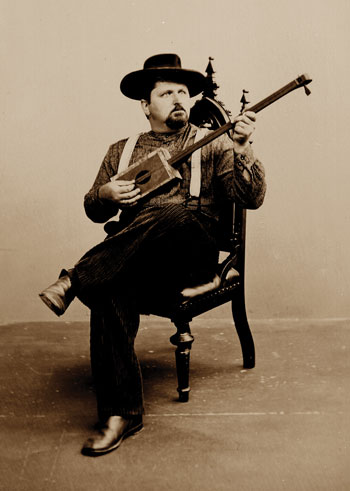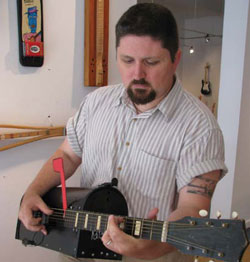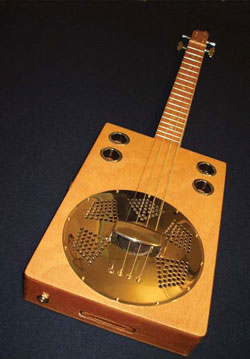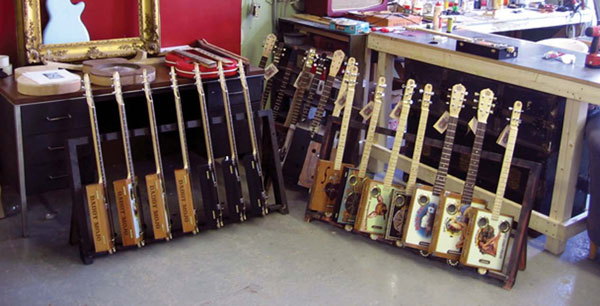|
雪茄盒王国:现代雪茄盒吉他风潮 Bob Cianci,翻译Stone654 
图为Shane Speal,这张照片采用美国内战时期的摄影器材拍摄 摄影:Rob Gibson 我一直搞不清楚一件事情:我们这些吉他消费者是否已经失去了从*简单廉价的乐器中获得快乐的能力?当然这里我不是指大多数人的第一把Silvertone或Danelectro品牌的吉他,而是说只要花上几美元任何人都能自己制作的乐器,全部零件都能在旧仓库和烟草店找到。 我们杂志的大多数读者都倾向于购买高端的吉他,无论是手工定制琴还是工厂货,他们都如获至宝地供起来,也因此失去了对廉价乐器的兴趣。虽然说高端的琴自有它们的用武之地,但是自制乐器的学问也不少,Delta Blues风格的先驱们就证明了这一点。Muddy Waters, Son House, Bukka White, Mississippi Fred McDowel, 还有Jimi Hendrix这些人都有一个共同的特点:他们都是从雪茄盒吉他开始学习的,这种乐器不需要多少银子就能买到。 不如这样想想,使用价值3000美金的手工琴和手工音箱演奏Delta Blues这种接地气的风格肯定让人感觉不太对劲。 和我们预想不一的是,雪茄盒吉他并没有随着高端琴以及CAD/CAM技术的出现而消失。事实上,正如下文即将叙述的一样,雪茄盒吉他现在依然生机勃勃,一切都要感谢爱好者们自发成立的小组织。他们尽量不去碰量产琴,甚至刻意逃离现代社会的桎梏。雪茄盒吉他的演奏风格十分多变,从原声演奏到滑棒布鲁斯,再到民谣,情歌,甚至先锋音乐、中东音乐、醉汉哼唱、牢歌、爵士摇滚融合乐以及金属乐。基本上在正常吉他上能演奏出来的乐曲在雪茄盒吉他上同样也可以。 历史小课堂 根据一流的收藏家,雪茄盒吉他博物馆管理员Bill Jehle的说法,这种乐器*远可以追溯到1840年,Charles A. White先生的传记中如是记载。素描画家Edwin Forbes在1864年Frank Leslie的报纸上刊登了自己的作品,描绘了两个内战士兵用雪茄盒小提琴自娱自乐的光景。童子军创立者Daniel Carter Beard在1890年版The American Boy’s Handy Book中发表了对雪茄盒班卓琴的构想,雪茄盒尤克里里在当时同样很受欢迎。 Bill说,雪茄盒吉他的造型从收音机被发明的的时代就基本没变过。广播对这种乐器的宣传起到了至关重要的作用,人们终于可以听到它作为一种主音乐器出现在歌曲中了,这很酷。没过多久人们就热衷于购买这种乐器了,买不起的就想办法自己做一把。值得注意的是,演奏雪茄盒吉他的并不只是美国黑人,Rockabilly先驱Carl Perkins家境贫寒,*早就是在雪茄盒吉他上学习演奏的,很多前辈都是如此。 
Bill的雪茄盒吉他收藏(细节见原文) Bill有着世界上*大规模的雪茄盒吉他收藏。“当我刚开始接触他们时,”他说,“我先是在ebay网上买了一些货。Shane Speal和我一起开始了对这种乐器历史的研究工作,我们经常互相交流。一天他发邮件给我说要卖掉他的全部收藏,我马上表示要去看看。那里约有65把雪茄盒吉他和其他一些小乐器。自那时起我便开始在这个基础上添砖累瓦,但收藏变得越来越困难,因为行情越来越紧俏。在网上任何一把雪茄盒吉他都会马上被炒成天价,但也有一些人愿意便宜卖给我或无条件送给我,他们希望手上的乐器能够善始善终。” 雪茄盒吉他之王 Shane Speal是一个土生土长的纽约人,自封为雪茄盒吉他之王。显然他并不是唯一一个从事相关工作的人,但被普遍认为是业界大佬,一个倾其一生向世界宣传这种乐器的男人。 “我是个不折不扣的音乐怪人”,他说。“年轻时我弹奏钢琴和吉他,80年代末开始在学校的金属乐队打鼓弹贝斯。大学时我察觉到Stevie Ray Vaughan和Jimi Hendrix他们风格的布鲁斯乐开始走下坡路了。不久我接触了Muddy,、the Wolf以及Hound Dog Taylor这些人的音乐,开始慢慢回溯研究Delta Blues风格。一次我听到了Blind Willie Johnson的音乐,整个人都为之热血沸腾。其音乐内涵是如此丰富,比我以前听过的任何金属乐都要原始悠扬。等我开始钻研Delta Blues的时候,我用一把快散架的Stella吉他还有一个玻璃瓶当滑棒进行演奏。1993年,我和Carl Perkin进行了一场采访,他提到了自己学习吉他时使用的两根弦的雪茄盒吉他。我觉得我有必要自己造一把。灵机一动之下,我给它装了三根弦,用火花塞帽当滑棒。就在三周前,我还绞尽脑汁试图在这把吉他上演奏Sylvester Weaver的Guitar rag。拿起这把琴时,旋律会很自然地从指板上涌出,又一种充满了细沙和泥土的温暖三角洲的感觉。” “一把雪茄盒吉他在刚开始的时候会显得奇怪破旧,并不适合演奏音乐。我喜欢人们在看我用它演奏优美音乐时露出的惊讶表情。”Bill Jehle说。“Shane听起来就像是在微型乐队里演奏的Motörhead一样!”当被问及为何给自己起名为“雪茄盒吉他之王”的时候,Shane回答说:“这是自嘲的说法,谁会认真给自己起名为这种不登大雅之堂的乐器的帝王呢?” 
Shane Spear正在弹奏Mailbox Dobro “我的录音棚里有很多传统的吉他,但我只是在录伴奏的时候才会用到它们。唱片中剩下的所有空间,都属于雪茄盒吉他和我的’Mailbox Dobro‘,它是由黑铁皮信箱做成的。我是一个雪茄盒吉他演奏家,我不关心所谓的乐器地位这种概念。” 2003年Shane在雅虎论坛上建立了一个雪茄盒吉他专区,主要靠成员共享其信息、相片、技巧和乐器来维持运营。“成立之初确实有一个很好的势头,很多音乐人都注册加入了这个论坛。他们分享自己的经验,把论坛变成了一个大家庭,人们很快被这里的积极有趣的氛围吸引。至于我本人,当然对这一切也有贡献。我就像一位吉他传教士,想让人们体验一场建立在友谊和对音乐热情之上的革命,而不是以自我或混乱为中心。这有效果,而且会更好。” 为什么这个组织如此关注这种原始的乐器呢?Shane说:“雪茄盒吉他没有严格的制作和演奏上的规定,可以随心所欲地弹奏。很多雪茄盒吉他小圈子都在招兵买马,当其他人都在模仿Eric Clapton和Pink Floyd的时候,这些人正在独树一帜地创新。”Shane现在经营着一个叫做cigarboxnation.com的网站,有超过600名活跃用户撰文。之前的那个雅虎专区也有超过三千名会员。童子军们目前把雪茄盒吉他当成勋章来颁发,Tom Waits和P.J. Harvey也曾在专辑上使用过这种乐器,Billy Gibbons也曾演奏过雪茄盒吉他。 至于雪茄盒吉他的未来,Shane表示:“琴友只会越来越多,但我们并不想靠这个出风头。由于唱片产业受到的毁灭冲击以及广播业的发展,黄金时代已经过去。现在音乐产业变得更紧凑精简,许多音乐家身身兼自己的经纪人和出品人。这很有趣,有了电脑,我们可以自己掌控录制传媒等环节。我有自己的唱片品牌insurrectionrecords.com,同时我会在shanespeal.bigcartel.com出售我自己制作的乐器。雪茄盒琴友懂得充分利用互联网资源,我们有自己的独立品牌、杂志、音乐节、网络圈子,以及自愿给琴友提供帮助的人家。这些都代表着雪茄盒吉他的未来,同时也是音乐产业的未来。” 推动者&演奏家 Shane Speal作为雪茄盒吉他圈内地位无可比拟的大佬,获得推动者的头衔当之无愧。 David Williams白天是一名科学家,晚上则化身为雪茄盒吉他琴友。作为国内一流演奏家之一,这个来自费城的老好人有着另外一个身份:’One String Willie’。只需要简单变个装并开始演奏,另一个角色就会出现在你面前。他刚推出了一张新专辑:You Gotta Hit the String Right(To Make The Music Swing),你可以在他的网站onstringwillie.com上获取相关信息。 
John McNair制作的吉他 对于*近出现的雪茄盒吉他风潮,Williams评论道:“自己制作和演奏乐器可以让我找到属于我自己的声音,而不是模仿那些知名的演奏家。我不认为雪茄盒吉他是一种歪门邪道,而是把它当成一种帮助人们找到属于自己的声音的渠道。爱好者大都是热衷生活,乐于助人的那种。Williams用自己的真名发行唱片,并帮助其他音乐家出了两张传统乐器的专辑。” Ted Crocker是一位来自新泽西的制琴师和琴盒匠,*近上映的电影Honeydripper (Danddy Glover主演,饰演一名快倒闭的小酒吧的老板)中的那把小吉他就是由他制作的,在他那里你可以买到同款。形状有点像Bo Diddley吉他,不过有些细微的不同。Ted还制作了一种叫Six Bonger的吉他(有点像Telecaster),它装有一个单线圈拾音器。Shane Speal收藏有一把原型琴,我试弹了一下。那是一把不错的滑棒吉他,售价也很合理,起价五百美金。 Ted也会制作各种各样的雪茄盒吉他,以及Terraplane footboard stomper、木质吉他拨片、Stonehenge牌拾音器等。(适合各种六弦吉他)你可以在ebay上购买Ted的产品,或访问tedcrocker.com。 Ben Prestage是一名雪茄盒吉他演奏家,巡演十分频繁,今年夏天会去欧洲巡演。你可以在他的My Space主页上查看他的五张专辑,以及Youtube上的诸多投稿。Prestage也被视为雪茄盒吉他首屈一指的推广者。 
John McNair的作品Red Dog系列中的Hound Dog型号 John McNair( 江湖人称Red Dog)是一位具有典型离经叛道精神的雪茄盒吉他琴师。由于卡特丽娜飓风灾害,McNair搬到了波多黎各,并制作出了质量数一数二的雪茄盒吉他。他运营者一个网站:reddogguitars.com,上面的信息非常丰富,有很多令人惊艳的吉他照片。 Richard Johnston是一位孟菲斯的街头艺人,平时演奏一些R.L. Burnside和Junior Kimbrough风格的密西西比乡村布鲁斯音乐。Johnston被视为能够复兴布鲁斯的青年人才,就像Stevie Ray Vaughan多年以前那样。Johnston得事迹*近还被拍成了电影(Richard Johnston: Hill County Troubador),由纪录片导演Max Shores拍摄。 Max Shores*近又拍摄了另一部有关雪茄盒吉他的纪录片:Song Inside the Box,这部电影介绍了许多本文提及的音乐人。“在听到Richard Johnston的演奏之前,我真的对雪茄盒吉他没啥好感。”Max Shores说。“我对人们用这种乐器演奏的美妙程度和表现力感到惊讶,同时也被人们从中获得的乐趣以及制琴师爱好者们可以通过互联网一起愉快交流这件事深深地打动。当他们拿起雪茄盒吉他开始演奏的时候,许多隐藏的感情就可以被释放出来。这些人有能力展现美好的音乐艺术,并且一生都在坚持。认识他们极大地丰富了我的生活。”(欲知详情,请点击songsinsidethebox.com) Gerry Thompson是一名歌手、词作家和吉他演奏家,也是雪茄盒吉他界的领军人物。Gerry在1989年之前长期酗酒达20年,之后安定了下来,重读了大学,结了婚,并且成功进行了两次肝脏移植手术。出于偶然他接触了雪茄盒吉他,并在2000年参加了在Carrolton举行的第一届雪茄盒吉他比赛。当时他被琴师Kuet Schoen忽悠上台,Thompson之前并没有演出的经历,只准备了三首歌,然而当场即红。他的音乐继承了鲍勃迪伦的早期风格,旋律富有音乐性,歌词深刻地反映了他的生活。 “我在发病的前一年戒了酒”,他说。“医生说我活不过一年,我现在还能说话是一种运气,我向。肝脏移植给了我新的生命,我又开始怀揣梦想。十年后,我开始把这些梦想用我歌曲的形式讲述出来,一切都很简单、纯粹,我只是在叙述自己的生活经历。雪茄盒吉他给了我自由的话语权,事实就是如此。” Dave Gallaher,江湖人称’Microwave Dave’,是一位天赋异禀的阿拉巴马布鲁斯演奏家,他成功地把雪茄盒吉他应用到他的电声和原声演出中。除此之外,他还会演奏一种叫Lowebow的乐器,由孟菲斯的琴行老板兼演奏家Johnny Lowe发明。更知名的叫法是’Johnny Lowebow’,这是一种双颈的雪茄盒吉他,有一根贝司弦和三根吉他弦,用滑棒进行演奏。Lowebow 是一种灵活性极强的乐器,演奏者可以同时演奏吉他和贝斯声部。 来自克利夫兰的Eric Baker制作过数种不同型号的Joker品牌的雪茄盒吉他,并在其店里贩卖。欲知详情,请访问jokercbg.com。 *后我们来介绍Daddy Mojo,亦即Lenny Piroth-Bobert。他来自加拿大魁北克的蒙特利尔,和他的合伙人还有两位雇员一起制作高品质的定制雪茄盒吉他。其中,Dolorosa和Vargs系列有着令人惊艳的外观设计。欲知详情,请访问daddy-mojo.com。 
六弦版的Dolorosa,由Daddy Mojo制作 总结一下 不得不承认,从前笔者的思维一直局限在传统吉他的世界里。通常你会去琴行买一把吉他,接到效果器和高级的电子管音箱上,模仿你的偶像演奏。但自从接触了雪茄盒吉他之后,我的人是上升到了一个新的层面,并开始准备这篇文章。我不是说要把自己的收藏都卖掉专门演奏雪茄盒吉他,而是把它作为一种音色的补充。这个过程中我认识了许许多多的琴友,上上网站、听听音乐、和音乐人还有琴师聊聊天。多多感受一下雪茄盒吉他的世界,它会彻底改变你的你的生活。 
Daddy Mojo的工作室 原文: Cigar Box Nation: The Modern Cult of the Cigar Box Guitar Bob Cianci July 22, 2009 A nagging question has been bothering me for some time now: have we, the guitar-buying public, lost sight of the joy of making music on a rudimentary, inexpensive stringed instrument? I’m not referring to your first Silvertone or Danelectro either. I’m talking about a guitar that almost anyone can make for a few bucks, with simple, everyday materials easily found in your neighborhood hardware store and smoke shop. Most of us who read this magazine like to ogle, purchase and play high-end guitars, of both the boutique and mass-produced variety, treating them as precious objets d’art, often missing the satisfaction and discovery of creating music on a simple, inexpensive instrument. While high-end guitars have their place, there’s a lot to be said for getting deep into something with a raw edge, just as the Delta blues pioneers did. There’s one thing Muddy Waters, Son House, Bukka White, Mississippi Fred McDowell, Jimi Hendrix, and many others had in common: they started playing on homemade cigar box guitars, fashioned with materials that were readily available in their humble circumstances. Think of it this way—can you really imagine playing raw, feral Delta blues on a $3000 custom-shop guitar and a handwired boutique amp? There’s something painfully wrong with that picture. Contrary to popular thought, cigar box guitars did not die out with the onset of “better quality” instruments and CAD/CAM technology. Indeed, the CBG, as I will hereafter refer to it, is alive and quite well, thank you, among a small but extremely dedicated group of near-fanatical followers—a “cult” if you will, though I use that word in the most positive sense—many of whom consider themselves musical outsiders who revel in their non-conformity, eschew mass-produced instruments, and sometimes the trappings of modern society itself. The music made on CBGs can vary wildly, from acoustic and electric slide guitar blues, to folk songs, murder ballads, avant-garde noise, Middle Eastern drone, drunken sing-alongs and junkie laments, to jazz/rock instrumental fusion, and even metalloid hard rock. Pretty much anything you can play on a “store bought” guitar can be played on a CBG. A Little History Lesson According to Bill Jehle, the foremost collector of antique cigar box guitars, and curator of the Cigar Box Guitar Museum, cigar box instruments date back as far as 1840, as mentioned in the biography of a Mr. Charles A. White. Sketch artist Edwin Forbes published one of his works in Frank Leslie’s Illustrated Newspaper in 1864, depicting two Civil War soldiers entertaining themselves with a cigar box violin. The founder of the Boy Scouts, Daniel Carter Beard, published plans for a cigar box banjo in his 1890 edition of The American Boy’s Handy Book. Cigar box ukuleles were also popular back in the early days. Bill comments, “Cigar box guitars made their appearance about the same time as the invention of the radio. Broadcast music featuring the guitar was critical. Folks could finally hear the guitar as a lead instrument, and that made the guitar cool. It follows that people wanted to play the guitar, and not being able to afford one naturally lead to building one out of whatever was handy.” It’s notable that cigar box guitars were not just a phenomenon of African-Americans. Rockabilly pioneer Carl Perkins, the son of a dirt-poor tenant farmer, started on a CBG, and he wasn’t alone by any means. Bill possesses the world’s largest collection of vintage CBGs and related instruments. “When I first started researching cigar box guitar history,” he says, “I had a few I bought on eBay. Shane Speal [more on him later] and I were both working on the history in parallel, so we would frequently exchange information. He emailed me one day to say he was selling the Cigar Box Museum, and I jumped at the offer. There were around 65 different cigar box instruments and all sorts of ephemera. I’ve added more to the collection since then, and it’s up to around one hundred cigar box instruments now. Finding additions to the collection is getting more difficult since more folks know about them now. Any vintage cigar box instrument on eBay is really hard to win, but I’ve also had people willing to sell me instruments for the sake of building up the museum collection. Some people just send me these things because they know it’s going to a good home.” The King of the Cigar Box Guitar Shane Speal, a native of York, PA, is the self-appointed King of the Cigar Box Guitar. While he’s certainly not the only practitioner of the instrument, he is universally recognized as the prime mover of the CBG cult, a man who has made it his life’s crusade to spread the word and promote the popularity of CBGs. “I’m a habitual musical hack,” he told me [Writer’s note: he’s being modest]. “I started on piano and guitar at an early age, played drums in school and played bass in metal bands in the late ‘80s. I discovered blues, Stevie Ray Vaughan and Jimi Hendrix in college and it was all downhill from there. I soon discovered Muddy, the Wolf and Hound Dog Taylor, and slowly worked backwards to the Delta stuff in a quest to find something deeper. Once I hit Blind Willie Johnson, my mind exploded. It was gritty, raw, and meaner than any heavy metal I ever heard. By the time I entered that Delta blues phase, I was playing a beat-to-hell Stella guitar with bad action and a bottleneck slide. Then, in 1993, I came across an interview with Carl Perkins where he described the simple two-string cigar box guitar he learned on, and I just had to build one.” “I got fancy and gave it three strings, and used a spark plug socket as a slide. Just a few weeks prior, I had been killing myself trying to play Sylvester Weaver’s ‘Guitar Rag’ on my acoustic. When I finished the three-stringer, that song just flowed out. It had the sound of grit, dirt and sweat of the Delta.” “A CBG is quirky and appears ‘broken’ from the start. They just don’t look like they should play any music. I love to see jaws hit the floor when I shove a socket on my finger and wail away.” According to Bill Jehle, “Shane sounds like Motörhead in a jug band!” When questioned why he named himself the “King of the Cigar Box Guitar,” Shane replies, “It’s a celebration of absurdity. Who would ever want to call himself the king of such a shitty instrument?” “I have many normal guitars in my studio, but I only use them as backing instruments while recording. The rest of the CD is CBGs and my evil ‘Mailbox Dobro,’ which is made from an actual black metal mailbox. I am a cigar box guitarist. I’m just not interested in status quo instruments anymore.” Shane started the Cigar Box Guitar Forum on Yahoo/Groups in 2003 with the provision that members share everything they had on the subject: information, photos, playing tips and instruments. “There was a certain electricity with the handful of musicians who joined up back then,” he says, “an electricity that’s increased over the years. They joined in with info sharing and turned the forum into a family. With a positive and fun atmosphere like that, lurkers were drawn in like magnets. Was I responsible? Yeah, I was like an evangelist. I wanted people to experience a musical movement that wasn’t based on ego or rebellion, but on friendship and a fascination for new music. It worked. Go figure!” But why has this cult formed around these primitive instruments? Shane remarks, “There are no rules as far as building or playing CBGs. If you can dream it, then do it. There is an army of CBG’ers encouraging new recruits to build their own. While the rest of the world is rehashing Eric Clapton and Pink Floyd tablature, we’re blazing new trails. We’re writing history as we go along.” Shane now runs a website called CigarBoxNation.com that boasts over six hundred active members at this writing. The old Yahoo/Group forum has over three thousand members. Boy Scouts and Cub Scouts are now building CBGs for badges. Tom Waits and P.J. Harvey have used CBGs on their albums. Billy Gibbons even plays them. As to the future of the CBG, Shane proposes, “The future is friends… more friends. None of us expect to make ‘the big time’ from this. The ‘big time’ doesn’t exist anymore due to the destruction of the record business and the horrible conglomeration of the radio industry. Music has been thrust back into a more regionalized stage, where performers are their own booking agents and record companies. This is an amazing thing. With a home computer, we now control our own printing press, recording studio and networking system. I have my own record label, insurrectionrecords.com, and I sell my homemade instruments on shanespeal.bigcartel.com. The cigar box guys are using computers, and quite effectively. We have our own indie labels, magazines, festivals, social network, and a dedicated family that will do anything to help each other out. This is the future of CBGs and the whole music industry.” Movers & Shakers & Cigar Box Heroes Shane Speal, while the acknowledged leader of the CBG movement, is by no means its only practitioner. David Williams is a research scientist by day and cigar box guitarist by night. Regarded as one of the leading CBG players, this mild-mannered resident of the Philadelphia area transforms himself into his alter ego, One String Willie, with a simple change of clothes, and performs on a homemade, one-string diddley bow. Williams/Willie has a new CD, You Gotta Hit the String Right (To Make The Music Swing), available on his website: onestringwillie.com. On the CBG phenomena, Williams comments, “Making and playing homemade instruments has allowed me to find my own musical voice, and to express myself without feeling the need to imitate an established musician. I don’t view the cigar box/homemade music community as a cult, but rather as a far-flung group of people from all walks of life who are passionate and supportive about helping others to make something that is uniquely their own...” Williams also records under his given name, and has also released two CDs of vintage, historical diddley bow recordings by other artists. Ted Crocker is a luthier and guitar case maker in southern New Jersey. He constructed the crude but hip solidbody guitar used in the recent film Honeydripper starring Danny Glover as the owner of a failing juke joint saved by a young guitarist who comes with a homemade guitar offering to play. You can buy a Honeydripper guitar just like the one used in the movie. The shape is close to the famous Bo Diddley rectangular instrument with a couple of alterations. Ted also makes a guitar called the Six Banger (which slightly resembles a Telecaster) with one single-coil pickup. Shane Speal owns the prototype, and I have played it. It’s one badass slide guitar, and it’s priced right, starting at five hundred bucks. Ted also makes various cigar box guitars, plus the Terraplane footboard stomper, wooden guitar picks, and his own Stonehenge brand pickups, which are available in one to six string configurations. You can find Ted’s pickups and accessories on Ebay, or you can purchase them directly through his website: tedcrocker.com. Ben Prestage is a one-man-band who plays CBGs and is also an extremely busy artist who tours constantly, keeping up a punishing schedule that includes a trip to Europe this summer. His five rootsy-bluesy CDs are available on his MySpace page, and he has numerous videos up on YouTube. Prestage is also considered one of the leading CBG exponents. John “Red Dog” McNair is a CBG builder who typifies the renegade spirit of the CBG. Displaced by Hurricane Katrina, McNair wound up in Puerto Rico with his family, where he builds some of the flashiest CBGs in existence. His quirky website, reddogguitars.com, is a veritable treasure of information, and the photos of guitars he has built are stunning. Richard Johnston is a Memphis street musician and one-man band who plays his own brand of traditional northern Mississippi hill country blues, in the style of R.L. Burnside and Junior Kimbrough. Johnston has been tapped as the next young musician capable of turning young people on to the blues, as Stevie Ray Vaughan did years ago. Johnston was the subject of a recent film, Richard Johnston: Hill County Troubador, directed by documentary filmmaker Max Shores. Max Shores also recently completed another documentary on CBGs, Songs Inside the Box, which features many of the musicians mentioned in this article. “I really didn’t have much appreciation for CBGs before I heard Richard Johnston play one,” Shores remarks. “I am amazed by the wonderful music people are making with CBGs, and the level of expression many builders display. I am also deeply moved by the joy people have found through these instruments and the camaraderie that has developed as CBG makers and players have networked through the Internet…. When they play their CBGs, many of them expose eccentric characteristics that might otherwise remain hidden, because the CBG gives them license to do so. These are great people making great art and music and having the time of their lives doing so. My life has been enriched by getting to know these folks.” Learn more at: songsinsidethebox.com. Gerry Thompson is a singer, songwriter and guitarist, and another leading light of the CBG movement. Gerry lived life on the edge in an alcoholic haze for twenty years before getting clean in 1989. He has settled down, gone to college, married, and has survived two liver transplants. Gerry stumbled onto the CBG after trying to play a poorly made mando-banjo. He attended the first CBG festival in Carrolton, KY, in 2000, and was coaxed onstage by CBG builder Kurt Schoen. Thompson, who had never performed in public before and only had three songs prepared, was a hit. His music is reminiscent of early Bob Dylan, and is lyrical, poignant and very melodic, with lyrics drawn from his life experiences. “I quit drinking a year before I got sick,” he says. “The doctors said I had less than a year to live. I’m in a weird state of grace, I guess. The transplant changed me. I started having dreams that were mine, but I wasn’t in them. A decade after the transplant, I just started (playing)… they all started coming out as songs. It’s simple, primal. I just tell stories about my life. Freedom. That’s what the cigar box guitar gave me. That’s what it’s all about.” Dave Gallaher, aka Microwave Dave, is a talented Alabama-based bluesman who effectively incorporates CBGs into his electric and acoustic shows, as well as an instrument called the Lowebow, invented by Memphis music store owner and guitarist Johnny Lowe, better known as “Johnny Lowebow.” The Lowebow is a doubleneck CBG with one bass string and three guitar strings. Played with a slide, the Lowebow is a deadly weapon in the right hands, allowing the player to be both guitarist and bassist at the same time. Eric Baker of Cleveland, OH, makes several different models of Joker brand CBGs in his shop and features a podcast on his website: jokercbg.com. And finally, Daddy Mojo, aka Lenny Piroth-Robert, of Montreal, Quebec, Canada, makes custom-made, professional-quality CBGs in his shop, along with his partner and two employees. The Dolorosa model in particular, with its screenprinted heart/cross/barbed wire artwork is an absolute stunner, as are the Vargas-inspired pinup models. Visit their website: daddy-mojo.com. Wrapping It All Up Admittedly, this writer comes from the traditional school of guitar thought. You go to a music store (or eBay), buy a guitar, plug into your high-quality tube amp and stompboxes and play, usually imitating your axe-wielding heroes. All that changed to a great extent after I became aware of the CBG movement and began to dig deeper in preparation for this article. I’m not saying that cigar box instruments are going to force me to put all my treasured guitars up for sale, but CBGs now have a place in my arsenal of sounds, and I have made several new friends in the process. Visit the websites. Listen to the music, talk to the players and builders. Open your mind and soul to the world of the cigar box guitar. You may never be the same. |



